- The Masol findings, if true, could complicate or deepen the out-of-Africa migration theory
Here Lies The First Human... Perhaps
Cut marks on bone fossils found on an Indian foothill could well change the narrative on human evolution
- It would make Masol in the Shivaliks, 20 km from Chandigarh, Asia’s oldest anthropological site
- The Indo-French discovery could push back out-of-Africa migrations by about 5,00,000 years
- Tells us more on how and when we started looking and behaving like homo sapiens rather than apes
***
Masol, an inconspicuous village tucked away in the lower reaches of the Shivaliks in Punjab with a smattering of vegetation, has raised a question fundamental to our existence: where and when did the first member of our species walk on this earth? Is it possible that ‘modern humans’ emerged first in Asia, or more precisely, what is present-day India, and not Africa, as is widely believed across the world? And that, too, half-a-million years before the point where the evolutionary timeline is said to have ticked off going by the fossilised evidence in Africa?
Yes, palaeoanthropology might have just run into a watershed moment at Masol. In a discipline rife with claims and counter-claims, where it isn’t always easy to separate scientific findings from their interpretations coloured by concerns non-scientific, the discoveries at this village near Chandigarh are bound to lead to furious debate. They may well hold the key to some startling possibilities, shake up conventional wisdom on the timeline of our evolution, rewrite the human story and, maybe, even rattle the very foundations of anthropology.
Making our way through dried-up rivulets to a plateau 100 metres above Masol and framed by dusty hills, we find ourselves at an outcrop of bedrock said to bear traces of hominins (our first intelligent human ancestors) in the sub-Himalayan floodplains. This is the place where an Indo-French team led by Mukesh Singh of the Society for Archaeological and Anthropological Research, Chandigarh, and Anne Dambricourt-Malasse of the French National Centre for Scientific Research, Paris, has claimed to have found traces of some of the earliest intelligent human activity. They have discovered stone tools and animal fossils—some showing cut marks most likely to have been made by early humans while scavenging—believed to date back 2.6 million years.
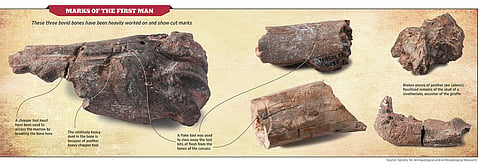
“The cut marks have been made by the sharp edge of a chopper or a flake of quartzite. They cannot be confused with natural scratches, or marks made by the teeth of crocodile or hyena,” says Dambricourt. Singh claims that anthropic scavenging at Masol is a scientifically proven discovery: “The hominin was not a hunter but a scavenger back then, who used to claw meat off the bones and break them to eat the marrow.” Manzil Hazarika, a palaeontologist at Bern University in Switzerland, who discovered the shin bone of a bovine ancestor from a cliff here, says that the fossil bore cut marks and its age was exactly the same as that of the surrounding rocks.
A group of 10 multi-disciplinary scientists from Poland, Mexico and France recently pointed out in the journal Comptes Rendus Palevol that extensive research since 2008 covering a span of 80 hectares in Masol was aimed at verifying a chronologically surprising discovery, which throws open some crucial questions: Did hominids from a very early stage of evolution settle in Asia even before they could stand erect? And, more tantalisingly, could the primitive species have evolved into the more sophisticated homo erectus in Asia itself?
The haul is quite huge: the research group in Masol has found over 1,500 fossils and 250 tools so far from the 13 sites they have surveyed. Three of those bovid fossils (bovids are the largest variety of hoofed mammals, of the cow family) bearing prominent cut marks were sent to the Centre for Research and Restoration of Museums of France and the National Museum of Natural History in Paris on the recommendation of the Archaeological Survey of India. They were tested there and found to be authentic.
Yves Coppens, the iconic professor emeritus at College of France, who discovered ‘Lucy’ and played godfather to generations of palaeoanthropologists, favours the idea that hominins left Africa long before 2.5 million years ago. He says the findings are in line with what he has been propagating since the 1980s. “I’ve been anticipating this,” he tells Outlook. “But suggesting something is not enough in science, you have to demonstrate. This demonstration is coming, and even trespassing my ‘audacious’ suggestion.” To Dominique Cauche of the Laboratory of the Prehistory Department at Lazaretto, Nice, Italy, besides pushing back the dates on migration from Africa, “the findings raise a bigger question.” If hominins were indeed present in Masol at that time, when and where did they come from?
Things would perhaps become clearer if and when hominin fossils are found in the area. “We will conduct more excavations in November and hope to find a hominin here,” says Singh.
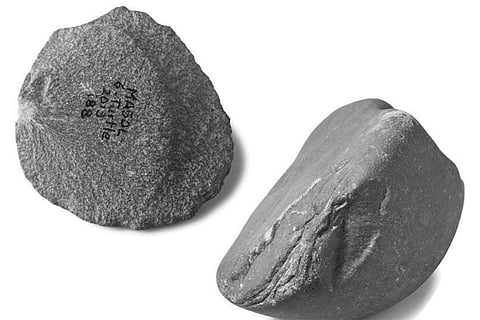
Early Tools A flake (left) and a chopper of quartzite, used to scavenge carcasses
What has piqued the curiosity of scholars is how fossils embedded for centuries have suddenly surfaced over the past few years in this region. Some say Masol—in geological terms, a ‘buttonhole’ region situated in the lower Himalayas—is an eroding dome that has slowly risen due to tectonic activity between the Himalayan and Eurasian plates, which increases the height of the Himalayan range. “With erosion by rivulets over the years, the fossils are coming to the surface,” says Singh. As we start to notice the horizontal layers of differently aged rocks on the hills around us, Singh points to a pinkish mound of silt and says, “I found it here.” That eureka moment was in 2008: it was the first chopping tool, dated close to 2.58 million years.
The finds have got the scholarly community all excited. Captain Karnail Singh, director of the Government Museum and Art Gallery, Chandigarh, believes the past is finally unravelling itself. “The findings have generated a lot of interest in prehistory and how India could be the birthplace of civilisation,” he says. In January, Prime Minister Narendra Modi and French President Francois Hollande visited the Chandigarh museum to celebrate the Masol discoveries. Seen in context, the Masol findings could help us piece together the prehistory of the Shivaliks and understand the importance of the Upper Indus Basin in the spread of the Homo genus across Asia.
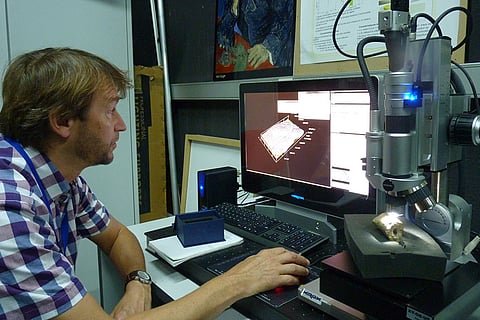
Evidence Bone fossils being tested in a Paris lab (Photograph by A. Dambricourt Malassé)
Scholars worldwide have been scrambling to set the evolutionary timeline right and understand the story of humanity’s origINS. Starting with a Neanderthal skeleton unearthed in Germany in 1856, there have been fiery and fairly technical debates around excavations in Africa, Europe and Asia. The out-of-Africa hypothesis began to be questioned after findings in China and Java in 1994 were found to be from approximately two million years ago. This sent prehistorians back to their drawing boards to map the new evolutionary tree.
The alternate theory, in sum, is this: that evolution took place in parallel streams and many sub-species of hominins emerged over centuries. Last March, scientists discovered the oldest jaw bones and teeth in the human ancestral line in Ethiopia, pegging it to 2.8 million years. The remains can be tentatively assigned to Homo habilis, a transitional species combining both ape and human-like features. The finding ruffled some feathers and met with some scepticism. Implications of the Masol discoveries could muddle up the timelines even more.
“If the cut marks on the bovid fossils found at Masol were indeed made by humans, that would be unprecedented for all of Asia,” admits Professor Michael Petraglia, co-director at the Centre for Asian Archaeology, Oxford. “The identification of the cut marks, however, is still contentious and difficult. It’s still early to say evolution did not start in Africa.” The key question is whether Masol buttresses the alternate theory of parallel evolutions, or merely deepens the out-of-Africa timeline. At any rate, despite sceptics voicing their reservations and calling for more thorough investigation, fieldwork and evidence to back the team’s extraordinary claim, Masol does put Asia right at the centre of the evolutionary jigsaw, along with Africa. It is, after all, a rich site: with ape fossils dated eight million years, found over a century ago.
Parth Chauhan, a palaeoanthropologist and assistant professor of humanities at the Indian Institute of Science Education and Research in Mohali, is a sceptic. He cites “methodological, interpretative and ethical” issues that deter the research from being “widely accepted”. He points out that “a French-dominated project published in a French-controlled journal” cannot be the last word on the subject. “Cosmogenic radionuclide dating is needed to ascertain the age of the stone tools,” he says. Rajeev Patnaik, professor of geology at Punjab University, too is convinced the tools are not from the Shivaliks. “These are surface finds,” he says, mentioning the lack of in-situ exploration or excavations done layer by layer to reveal artefacts.
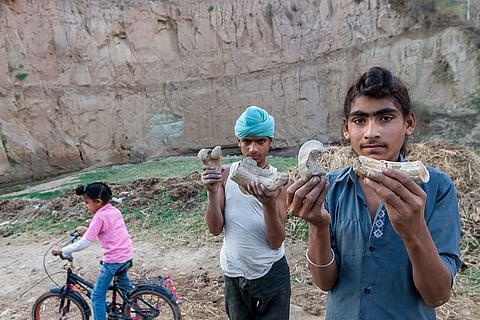
Prize Find Jassi (right), 16, and Gurbaksh, 15, show some bone fossils
There are others who are critical of the dating methods. A.R. Sankhyan, formerly of the Anthropological Survey of India, thinks the survey was not based on “absolute dating methods”. Even S.B. Ota, ASI regional director in Bhopal, who has been closely watching the excavations at Masol, says the tools have not been precisely dated. “The cut marks on the bones are clear, but even primates could have caused those indentations,” he says.
Chauhan takes it a step further, saying the marks could have been caused through natural contact with sharp stones or gravels. “If their finds truly represent 2.6 million-year-old hominin activity as a result of earlier dispersals from Africa, then we should theoretically find evidence of older dispersal between Africa and the Indian subcontinent,” he says.
G.D. Badam, scientific consultant at the Palaeo Research Society, Pune, admits to these concerns, but says the team did corroborate its findings with extensive research. Julien Gargani, an earth sciences specialist at the University of Paris-Sud and a member of the team, says the study clearly shows the presence of intentional cut marks on the 2.6 million-years-old fossils. “The research has many implications. The questions that arise from it are not just scientific but also philosophical,” he says.
Coppens points out that there are sites where early human activity did take place outside of Africa, but Masol would have to be oldest to be discovered so far. “I encouraged the team to explore deposits of this age in the Shivaliks,” says Coppens. “All the claims seem trustworthy, and the palaeomagnetic as well as stratigraphic dating are reliable.” Besides the fossils of animals believed to be ancestors of some of the current species, the Shivaliks have yielded the bones of a Stegodon (older version of the elephant with four-metre-long tusks), an Equus (ancestor of the horse) and giant terrestrial turtles.
Watching all this unfold before their eyes has sparked the interest of the villagers. They have been assisting the researchers in digging up trial trenches or transporting heavy fossils on the backs of camels and donkeys. Showing off his prize find that he has been lugging among much else in a cement sack, 16-year-old Jassi says, “This is the tooth of a hippopotamus. Who knows if this is going to be the next big thing for the professor?”
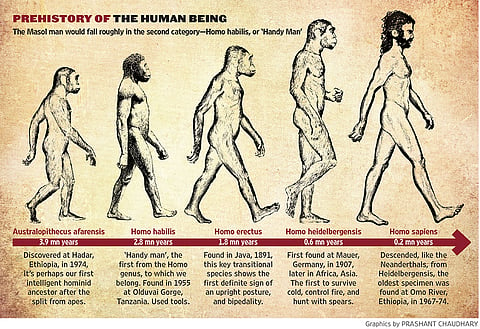
Discoveries such as this have become part of everyday life for the locals, though, as former sarpanch Kaka Singh laments, they do not always understand its historical significance. Villagers are often found at the site collecting curious-looking bones, and animals are sometimes seen trampling on the fossils. “The government should protect the site from trespassers,” he says. Indeed, that is the least the government can do. For there could be plenty of surprises lying here and there that could be of immense value to palaeoanthropologists and everyone agrees the site needs more study.
If new excavations do yield a hominin fossil—the stuff of Mukesh Singh’s dreams, in pursuit of which he has spent much of his professional life—could it point to an hitherto unknown branch in the human family tree? For now, the 62-year-old Singh is busy in his backyard closely examining every stone and fossil neatly stored in blue crates. His eyes twinkle when you ask him: “Is Masol really where it all began?”
By Siddhartha Mishra in Masol, with Priyadarshini Sen Photographs by Narendra Bisht
Tags